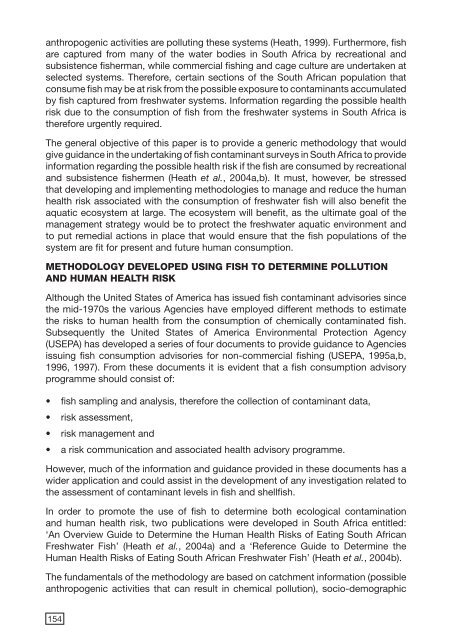Download as a PDF - CiteSeerX
Download as a PDF - CiteSeerX
Download as a PDF - CiteSeerX
Create successful ePaper yourself
Turn your PDF publications into a flip-book with our unique Google optimized e-Paper software.
anthropogenic activities are polluting these systems (Heath, 1999). Furthermore, fish<br />
are captured from many of the water bodies in South Africa by recreational and<br />
subsistence fisherman, while commercial fishing and cage culture are undertaken at<br />
selected systems. Therefore, certain sections of the South African population that<br />
consume fish may be at risk from the possible exposure to contaminants accumulated<br />
by fish captured from freshwater systems. Information regarding the possible health<br />
risk due to the consumption of fish from the freshwater systems in South Africa is<br />
therefore urgently required.<br />
The general objective of this paper is to provide a generic methodology that would<br />
give guidance in the undertaking of fish contaminant surveys in South Africa to provide<br />
information regarding the possible health risk if the fish are consumed by recreational<br />
and subsistence fishermen (Heath et al., 2004a,b). It must, however, be stressed<br />
that developing and implementing methodologies to manage and reduce the human<br />
health risk <strong>as</strong>sociated with the consumption of freshwater fish will also benefit the<br />
aquatic ecosystem at large. The ecosystem will benefit, <strong>as</strong> the ultimate goal of the<br />
management strategy would be to protect the freshwater aquatic environment and<br />
to put remedial actions in place that would ensure that the fish populations of the<br />
system are fit for present and future human consumption.<br />
METHODOLOGY DEVELOPED USING FISH TO DETERMINE POLLUTION<br />
AND HUMAN HEALTH RISK<br />
Although the United States of America h<strong>as</strong> issued fish contaminant advisories since<br />
the mid-1970s the various Agencies have employed different methods to estimate<br />
the risks to human health from the consumption of chemically contaminated fish.<br />
Subsequently the United States of America Environmental Protection Agency<br />
(USEPA) h<strong>as</strong> developed a series of four documents to provide guidance to Agencies<br />
issuing fish consumption advisories for non-commercial fishing (USEPA, 1995a,b,<br />
1996, 1997). From these documents it is evident that a fish consumption advisory<br />
programme should consist of:<br />
• fish sampling and analysis, therefore the collection of contaminant data,<br />
• risk <strong>as</strong>sessment,<br />
• risk management and<br />
• a risk communication and <strong>as</strong>sociated health advisory programme.<br />
However, much of the information and guidance provided in these documents h<strong>as</strong> a<br />
wider application and could <strong>as</strong>sist in the development of any investigation related to<br />
the <strong>as</strong>sessment of contaminant levels in fish and shellfish.<br />
In order to promote the use of fish to determine both ecological contamination<br />
and human health risk, two publications were developed in South Africa entitled:<br />
‘An Overview Guide to Determine the Human Health Risks of Eating South African<br />
Freshwater Fish’ (Heath et al., 2004a) and a ‘Reference Guide to Determine the<br />
Human Health Risks of Eating South African Freshwater Fish’ (Heath et al., 2004b).<br />
The fundamentals of the methodology are b<strong>as</strong>ed on catchment information (possible<br />
anthropogenic activities that can result in chemical pollution), socio-demographic<br />
154

















